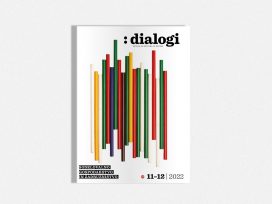Anxiety
For the last fifteen years, during what we call the transition period, the segment of Slovene society whose livelihood is derived in some form or another from books (ie authors, publishers, booksellers, and librarians) has been under constant stress. This stress has continued to mount over the past two years, fueled not only by the intrusion of commercialization and the so-called cultural industry into this sector, but also by legislation which is in a state of constant flux.
Twenty years ago, Slovene books which were recognized by the Ministry of Culture as having artistic value were not taxed. Nowadays we have a VAT on books of 8.5 per cent, and there is much talk of a proposed flat tax, which, if adopted, would mean a significantly higher level of taxation – in fact one of the highest tax rates on books in Europe – in a book market that is one of the smallest. The latest change in the income tax legislation hit authors hard by raising the tax owed on their honoraria. Parliament has already adopted a new law on the media, and one on the mandatory free issue of a certain number of copies of published works is currently under discussion. New regulations on textbooks are also causing controversy. There is an ongoing flurry of polemics, round tables, petitions, seminars, and congresses on the subject; there have even been some research studies conducted, and all this in a field which is professionally rather narrow and for as long as one can remember has been fairly stable.
It’s true that Slovene publishing houses from the time of socialism (when they were under social ownership) have weathered Slovenia’s subsequent independence relatively well. They have been privatized, partially merged, become more commercially oriented, and retained a large market share and a monopoly position in bookstores. After the Second World War, the state set up four publishing houses, by 1990 there were nearly twenty in operation, and with the new opportunities to set up private companies, their number grew by leaps and bounds. In addition to the commercialization of the old publishing houses, a number of new private commercial companies appeared on the scene, some of which grew to such an extent that they represented a source of serious competition to the older ones. At the same time, there were also a certain number of non-profit publishing houses established in a variety of organizational forms. Judging by the results of the latest research, these non-profits bear almost the whole of the responsibility for publishing literary works and specialist and scientific publications. Publishing as a field is thus divided into two distinct poles, which operate with completely different interests.
The non-profit publishing houses can carry out their mission only with the financial support of the state. Such support has a long tradition in Slovenia, given the intrinsic difficulties posed by such a small market. In 1961, when the Fund for the Promotion of Publishing first started operating, 799 books were published in Slovenia, of which the Fund subsidized 319, or 40 per cent. In 2004, 4460 books were published in Slovenia, of which the Ministry of Culture subsidized 335, or 7.5 per cent. A comparison of the data leads one to conclude that the publishing industry, or rather its commercialization, has proceeded apace in Slovenia (as the number of copies printed has fallen steadily, similar to the situation everywhere in the West), and the market supply, the number of subsidized books in the fields of literature and the humanities, and the target population have all remained unchanged. Or is there perhaps a different explanation possible?
Research has shown that roughly half of Slovenes do not buy books, and 40 per cent do not read them. Sales of books have steadily dropped, while library lending has greatly increased. In 1990, the average Slovene borrowed four books a year from the library; in 2001, the figure had grown to 11. Libraries have thus become a powerful actor in the Slovene book market. A story which reveals all the multiple layers and complexity of the situation started in the first half of 2005. At the beginning of the year, the Chamber of Commerce endorsed a set of rules for the uniform pricing of books, arguing that there should be order in the market, and books offered to buyers should be priced the same for everyone. Based on these rules, the large commercial publishing houses withdrew the discounts previously offered to public libraries. The reaction of libraries was completely unexpected: they resisted. The market was blocked. For libraries as publicly funded institutions, this behaviour was surprisingly market-like. Or perhaps not, looked at in light of the most recent studies, which show that public libraries have given in to the pressures of commercialization in the purchasing of books, and buy substantially more commercially produced titles than subsidized ones in order to maximize lending rates. On this basis, some researchers are already predicting market liberalization and the privatization of libraries, which places the interpretation of the story related above in a completely new light. The story unfolded toward the end of the year in such a way that the libraries once again got their discounts, and the government Competition Protection Office canceled the rules for the uniform pricing of books due to the restriction of free competition. The outcome revealed the power of libraries as buyers on the small Slovene market. And even though the commercial publishers complain that the lending of libraries reduces their sales, they themselves are beneficiaries of state funds through the reliable sale of their products to libraries. This is the point at which the commercial and the public interest become so closely intertwined as to be indistinguishable.
In the foregoing, we have used the results of some studies on the Slovene book market which attest to certain trends1, but a response based on the more fundamental issue of books as a value in a society in transition is lacking. If we Slovenes throughout our history as a nation without a state have always preserved and been grounded in books (language, literature, culture), then today’s moralizing about the love of Slovenes for books is irrelevant. Currently 1500 people are waiting to borrow a copy of The Da Vinci Code from libraries, even though the paperback is already available on the market for a mere EUR 12.50, which is considerably less than what the average Slovene spends on cell phone calls each month. So where, then, does this mentality of Slovenes, that books must be practically free of charge, come from? Does it originate from socialism, or is it the result of a different set of values brought by the consumer society, or is it perhaps some combination of the two? If we were to do research on values that could yield an answer to this question, it is conceivable that many of the dilemmas surrounding the proposed new laws and the forms of state financial support for books might simply disappear.
Research study "Books and readers IV" (M. Znidersic, D. Podmenik, G. Kocijan) from 1999, research study "Book culture" (M. Breznik, S. Novljan, J. Jug, A. Milohnic) from 2005.
Published 28 June 2006
Original in Slovenian
First published by Dialogi 5-6/2006 (Slovenian version)
Contributed by Dialogi © Emica Antoncic/Dialogi Eurozine
PDF/PRINTNewsletter
Subscribe to know what’s worth thinking about.



